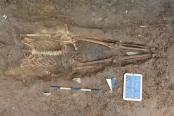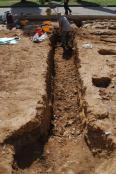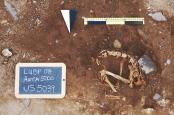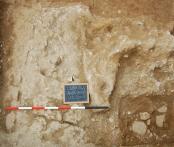CAMPAGNA 2014 |
1° SETTIMANA |
2° SETTIMANA |
3° SETTIMANA |
4° SETTIMANA |
5° SETTIMANA |
6° SETTIMANA |
7° SETTIMANA |
8° SETTIMANA |
08 LUGLIO 2014 
Resoconto della giornata di scavo
Area 2000
A causa del maltempo le indagini sono state interrotte durante tutta la mattinata. Nel pomeriggio è stato possibile iniziare lo svuotamento del taglio US -2286 individuato nell'allargamento Nord, nella porzione allineata al Settore B. Il taglio in questione ha una forma molto irregolare e potrebbe essere interpretato come livellamento effettuato in epoca moderna (come confermerebbero i materiali rinvenuti nel riempimento US 2287) durante i lavori per la costruzione del cimitero tutt'ora in uso e della strada.
Per quanto riguarda il Settore A si è conclusa la documentazione e la rimozione dello scheletro Usk 2436, probabilmente medievale, e di Usk 2412, posto nell'allargamento Ovest.
L'intera area è stata poi pulita per definire con esattezza i nuovi tagli sepolcrali parzialmente visibili che saranno indagati nei prossimi giorni.
In the north extension we pick-axed, attempting to find the end of the cut as well as better define it, and this will be continued tomorrow. The skeleton in the southwest corner of the 2000a extension was documented and fully removed. The cranium and right arm were missing. Another skeleton was discovered immediately beside the right femur. This second skeleton is more recent than the excavated skeleton. The skeleton in northeast corner of 2000a was also documented and removed. The orientation of the burial, as well as the black color of the cortical bone, indicate that the skeleton is probably from a medieval context. The bone was not well preserved and most of it fell apart upon removal. The extension of sector a was cleaned again and it is believed that we have found mortar belonging to the other cemetery wall.
Area 3000
La pioggia battente ha impedito di lavorare per gran parte della mattinata. È stato comunque possibile proseguire con lo scavo della trincea US – 3388, che, orientata W-E, attraversa tutto il Settore B: si tratta probabilmente di una canaletta realizzata in epoca ottocentesca con lo scopo di far defluire l’acqua dalla chiesa. L’effettivo orientamento della trincea in questione sarà meglio chiarito nelle giornate seguenti. È inoltre iniziata l’indagine della tomba a cassa litica US 3407, orientata S-N ed addossata alla porzione meridionale della facciata medievale USM 3380. Si è proceduto in particolare alla rimozione del riempimento superficiale (US 3408) a matrice limo-argillosa, di colore bruno, ricco di inclusi litici di varia pezzatura, scisti, laterizi ed ossa umane sparse. Nella porzione centrale e meridionale del settore sono stati infine individuati alcuni tagli di fosse sepolcrali che saranno meglio evidenziati nelle giornate seguenti.
In Area 3000, the extension of the trench was continued, which revealed 19th century pottery, archaic majolica, and human bones. The digging and the lowering of the trench will be continued tomorrow. In the morning the south east corner of sector B was leveled and cleaned to expose features and burials in the area. During this, multiple burials were discovered. One of these were oriented west-east, which is typical for the skeletons buried in front of the church. In addition, the excavation of the lithic tomb in the south west corner of sector A was started, exposing scattered bones and pottery. The excavation of the tomb will be continued tomorrow.
Area 4000
È quasi terminata, con oggi, la rimozione di US 4167, lo strato argilloso e molto compatto esteso sull’intera superficie dell’area; di natura antropica ed altamente depurato ad eccezione fatta per i numerosi frammenti ossei presenti in esso. La lunga rimozione dello strato ha già permesso la messa in luce di nuove evidenze che nei prossimi giorni saranno verificate, come una serie parallela di contesti subrettangolari allineati sull’asse nord-sud ed orientati est-ovest. Se si tratti di ulteriori sepolture di natura diversa da quelle già identificate sarà possibile confermarlo con le prossime operazioni di scavo.
Today at Field School Pozzeveri in Area 4,000 we continued to clean and level the surface to better define the different contexts. We have found three horizontal cuts between the two walls of the medieval hallway. These contexts are interpreted as possible burial sites for the monks and are identified by a change in color from light to dark clay. We also saw a transition in clay color on the Western side of Area 4,000 which may be a burial but is slightly longer than we expect burials to be. In addition, we also found scattered bones, including two newly discovered fractured crania. After the area was cleaned, aerial photographs were taken of the surface. Tomorrow our goal is to define the limits of the three newly discovered cuts.
Area 5000
Nella giornata di oggi, durante la pulizia della porzione settentrionale dell'area, è emerso un taglio nel cui riempimento è stato rinvenuto parte dello scheletro di un cane in connessione. Purtroppo la parte superiore dell'animale è stata intercettata da un'altra attività di asportazione di terreno, lasciando lo scheletro incompleto. Procede inoltre la pulizia del settore sud che continua a mettere in luce nuove attività localizzate in questa porzione del sito. E' stata infatti rinvenuta una grande buca circolare (US 5040), e un taglio ovale (US 5042)localizzato nella zona centro-occidentale di questo settore. E' cominciata infine la rimozione della fossa per lo spegnimento della calce, US 5010, relativa a fasi di cantiere per la ricostruzione o il restauro della chiesa avvenuti nella seconda metà dell'ottocento, come dimostrato dai reperti rinvenuti.
Due to inclement weather the morning was spent bailing water and cleaning area 5000. The off and on showers of rain made for quick specialized tasks. We continue to expose the context 5024, the yellow clay layer in the south east quadrant of area 5000. Another task performed was the cleaning of the mortar pit, context 5010. After a thorough cleaning, we photographed the area and took elevations. We then proceeded to remove lime and mortar with pick axes and shovels throughout the afternoon to expose the clay context beneath. During the morning the excavation of the spill from area 3000 along the northern wall, many bone fragments were collected. During this removal process we uncovered a peculiar articulation of vertebrae and long bones. After further examination and careful excavation, we believe these remains to be an intentional dog burial. We suspect the canine found is a juvenile due to the lack of femoral epiphyseal and vertebral disk fusion. This canine is missing its cranium, which is likely due to construction disruption. After pictures and elevations the bones were carefully removed and tagged.


















